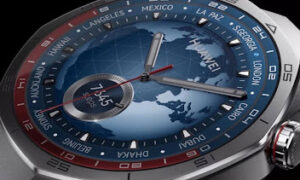The evolution of time-tracking has progressed from ancient sundials to today’s smartwatches. Though a hallmark of modern technology, the rising popularity of smartwatches also brings environmental concerns. While they are highly desired for their features and convenience, there’s an environmental cost associated with them.
The Manufacturing Impact
Smartwatches, while convenient and functional, have a manufacturing process that significantly impacts the environment. This includes resource extraction, energy consumption, and intricate production techniques.
Smartwatches use metals and minerals, including rare earth elements, for their design and functionality. Extracting these materials can lead to environmental problems like habitat destruction and contamination. Manufacturers face the challenge of balancing product demand with environmental responsibility.
Smartwatch production consumes significant energy, especially in assembly and component manufacturing, leading to increased carbon emissions. As demand rises, there’s a pressing need to balance technological progress with environmental sustainability.
The Use Phase
The environmental implications of smartwatches go beyond just their production. How we utilize these devices significantly affects their total ecological footprint. When in use, considerations like energy efficiency and the lifespan of the device become vital factors in assessing their environmental impact.
Smartwatches vary in energy consumption due to their features. Manufacturers are prioritizing energy efficiency, introducing adaptive settings and power-saving modes to combine functionality with sustainability and enhance battery longevity.
During a smartwatch’s use phase, consistent software updates and modular design can extend its lifespan and reduce waste. Users can further reduce their environmental impact by using energy-efficient settings and prioritizing repairs over replacements.
Lengthening smartwatch lifespan reduces environmental impact. Regular updates and proper care improve device longevity. Emphasizing repairability, especially with modular designs, helps in replacing parts rather than entire devices, minimizing electronic waste. This reduces the environmental strain from constant device production and replacement.
Initiatives by Brands
 Many smartwatch manufacturers, as well as sellers, i.e., Wick Watches, are adopting initiatives like recycling and sustainable production to reduce the environmental impact of their products.
Many smartwatch manufacturers, as well as sellers, i.e., Wick Watches, are adopting initiatives like recycling and sustainable production to reduce the environmental impact of their products.
Major smartwatch brands have launched recycling programs to combat electronic waste, urging users to return old devices for recycling or refurbishment, preventing them from polluting landfills. These initiatives enable the retrieval of precious metals and components from old smartwatches, reducing raw material demand and fostering a circular economy where used devices supply materials for new ones.
Manufacturers are adopting sustainable practices during smartwatch production by minimizing energy use, reducing emissions, and using eco-friendly materials like recycled and bio-based plastics. By optimizing manufacturing processes and focusing on efficient supply chains and renewable energy, they aim to balance technological growth with environmental responsibility. Consumer support enhances these eco-friendly efforts in the tech industry.
What Consumers Can Do
While manufacturers take significant steps to reduce the environmental impact of smartwatches, consumers also play a vital role in shaping the sustainability of the industry. By making conscious choices and adopting responsible practices, individuals can contribute to minimizing the ecological footprint of their smartwatch usage.
Mindful purchasing decisions by consumers can reduce environmental impact. Evaluating the real need for a smartwatch upgrade can decrease product demand and resource use. Additionally, choosing brands with environmental initiatives aligns purchases with sustainability values.
When replacing a smartwatch, use eco-friendly disposal methods. Manufacturers often offer recycling programs to repurpose old devices. Functional smartwatches can be donated or sold, while broken ones should be taken to e-waste centers. Such conscious decisions support a sustainable tech ecosystem.
The Role of Regulations and Policies
In the pursuit of a more sustainable future for smartwatches and the tech industry at large, the role of regulations and policies cannot be understated. Government intervention and industry standards play a pivotal role in shaping the practices of manufacturers and encouraging environmentally responsible behavior.
Government Regulations
Government regulations are crucial in ensuring responsible smartwatch production and disposal. As e-waste issues grow, authorities are setting guidelines covering everything from materials to waste management. These rules can promote the use of eco-friendly materials and ensure manufacturers manage product disposal responsibly.
Incentives for Sustainability
Governments can incentivize manufacturers to adopt sustainable practices through various means. This might include tax breaks or subsidies for companies that prioritize energy-efficient manufacturing, use recycled materials, or implement take-back programs for old devices. These incentives not only benefit manufacturers financially but also promote a shift toward more eco-conscious business models.
International Collaboration
International cooperation is essential for setting e-waste management standards in the global tech industry. Organizations like the International Electrotechnical Commission and the Basel Convention establish cross-border guidelines. Governments play a key role in enforcing sustainability regulations, with collective efforts aiming for a more sustainable tech future.
Looking Ahead
The future of smartwatches is undoubtedly exciting, with a growing emphasis on sustainability driving innovative advancements. As the tech industry acknowledges its responsibility toward the environment, several trends are emerging that promise to reshape the landscape of smartwatches and contribute to a greener future.
Manufacturers are using biodegradable materials like bioplastics in smartwatch designs to reduce e-waste. The emerging “circular design” principle emphasizes products designed for easy disassembly and recycling, aiming to retrieve valuable materials and minimize waste.
Manufacturers are incorporating energy harvesting technologies in smartwatches, including solar panels and kinetic mechanisms. These technologies utilize sunlight and the wearer’s movements to charge devices, reducing reliance on traditional power and cutting carbon emissions.
Consumers’ demand for transparency is leading manufacturers to practice ethical sourcing, ensuring environmentally friendly and fair labor practices. By tracing material origins and reducing transportation emissions, companies align with sustainability goals, appealing to conscious consumers.
Manufacturers are shifting from planned obsolescence to emphasizing longevity in smartwatches. They are prioritizing modular design, upgradability, and durability, with a focus on repairability. This approach aims to promote long-term device care and ownership, reducing replacement rates and minimizing environmental harm.
Conclusion
The smartwatch industry is navigating the challenge of combining innovation with environmental responsibility. Driven by research and consumer demand, man
ufacturers are turning to sustainable solutions. Both producers and consumers need to prioritize eco-friendly choices. The industry’s move towards sustainability highlights its dedication to environmental well-being, emphasizing the need for sustainable tech practices for a greener future.

































